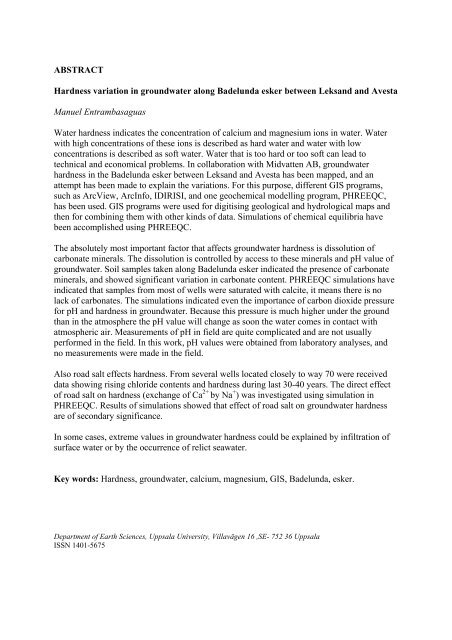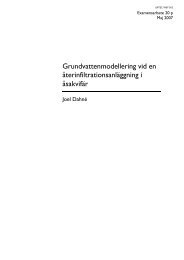Hårdhetsvariation i grundvatten längs Badelundaåsen ... - Midvatten
Hårdhetsvariation i grundvatten längs Badelundaåsen ... - Midvatten
Hårdhetsvariation i grundvatten längs Badelundaåsen ... - Midvatten
You also want an ePaper? Increase the reach of your titles
YUMPU automatically turns print PDFs into web optimized ePapers that Google loves.
ABSTRACT<br />
Hardness variation in groundwater along Badelunda esker between Leksand and Avesta<br />
Manuel Entrambasaguas<br />
Water hardness indicates the concentration of calcium and magnesium ions in water. Water<br />
with high concentrations of these ions is described as hard water and water with low<br />
concentrations is described as soft water. Water that is too hard or too soft can lead to<br />
technical and economical problems. In collaboration with <strong>Midvatten</strong> AB, groundwater<br />
hardness in the Badelunda esker between Leksand and Avesta has been mapped, and an<br />
attempt has been made to explain the variations. For this purpose, different GIS programs,<br />
such as ArcView, ArcInfo, IDIRISI, and one geochemical modelling program, PHREEQC,<br />
has been used. GIS programs were used for digitising geological and hydrological maps and<br />
then for combining them with other kinds of data. Simulations of chemical equilibria have<br />
been accomplished using PHREEQC.<br />
The absolutely most important factor that affects groundwater hardness is dissolution of<br />
carbonate minerals. The dissolution is controlled by access to these minerals and pH value of<br />
groundwater. Soil samples taken along Badelunda esker indicated the presence of carbonate<br />
minerals, and showed significant variation in carbonate content. PHREEQC simulations have<br />
indicated that samples from most of wells were saturated with calcite, it means there is no<br />
lack of carbonates. The simulations indicated even the importance of carbon dioxide pressure<br />
for pH and hardness in groundwater. Because this pressure is much higher under the ground<br />
than in the atmosphere the pH value will change as soon the water comes in contact with<br />
atmospheric air. Measurements of pH in field are quite complicated and are not usually<br />
performed in the field. In this work, pH values were obtained from laboratory analyses, and<br />
no measurements were made in the field.<br />
Also road salt effects hardness. From several wells located closely to way 70 were received<br />
data showing rising chloride contents and hardness during last 30-40 years. The direct effect<br />
of road salt on hardness (exchange of Ca 2+ by Na + ) was investigated using simulation in<br />
PHREEQC. Results of simulations showed that effect of road salt on groundwater hardness<br />
are of secondary significance.<br />
In some cases, extreme values in groundwater hardness could be explained by infiltration of<br />
surface water or by the occurrence of relict seawater.<br />
Key words: Hardness, groundwater, calcium, magnesium, GIS, Badelunda, esker.<br />
Department of Earth Sciences, Uppsala University, Villavägen 16 ,SE- 752 36 Uppsala<br />
ISSN 1401-5675



